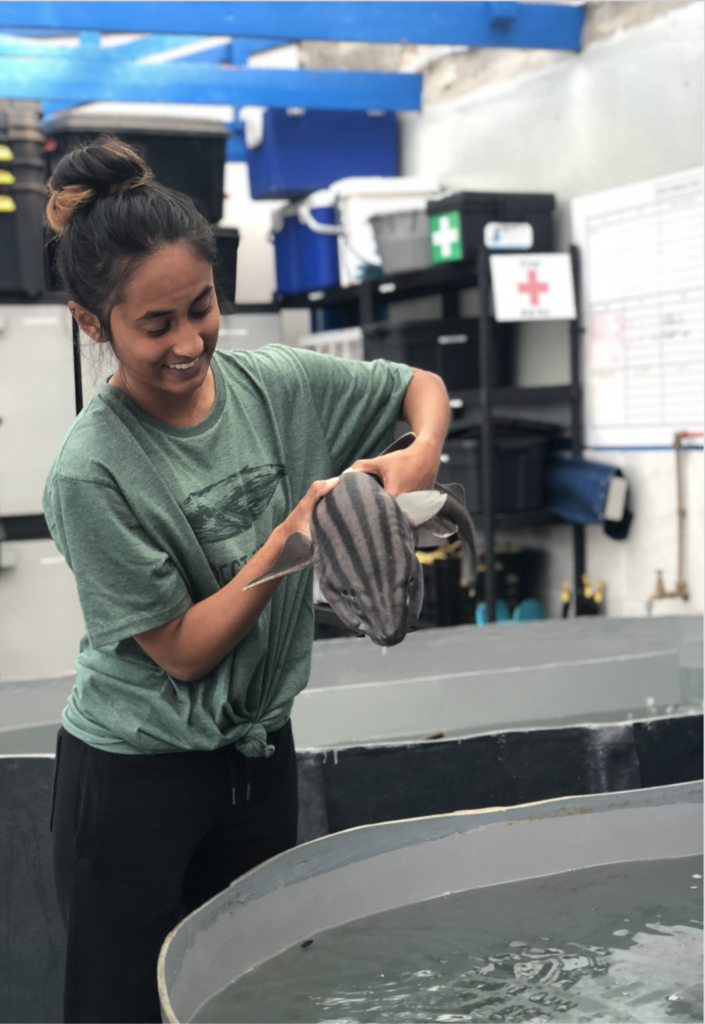The most common idea of a shark is known to be an animal with big teeth and large bodies. When tuning into the popular shark-based program shark week, this idea of a shark is what viewers are expecting to see. Because shark week has attracted millions of viewers each year, the program has continued to feature the same sharks overlooking some of the more interesting smaller species we have. I want to discuss a small and very unique species of shark, the Pajama Shark.
Last summer I had the opportunity of spending some time with one of my new favorite sharks that happen to be endemic to the coastal waters of South Africa. These sharks caught my attention because of their beautiful features and calm natured behavior.
Pajama Sharks, Poroderma africanum, is known as the striped catshark and are completely harmless to humans.
During my time in South Africa at the South African Shark Conservancy, I was able to spend a lot of time with them and learn more about this species.

Biology and behavior
The Pajama Shark is the largest member of the Catshark family.
They are a slow-swimming species distinguished by their long dark stripes along their back from head to tail, similar to pajamas! Pajama sharks also have short barbels above their mouth that help assist in foraging for prey.
They have well calcified dermal denticles that create their thick skin. Their skin is thick and not quite as rough because they spend most of their time swimming on the bottom.
Pajama Sharks can grow up to about 1.1 to 1.2 meters (110 to 120 cm).
Besides their beautiful stripes, another interesting feature of this shark is their donut shape. When these sharks feel threatened or scared, they curl up into a round shape with their tail covering its head, while also protecting their gills.

It was very interesting for me to see this shark display such a unique type of defense mechanism that other sharks can’t.
Distribution and habitat
The Pajama Catshark is endemic to waters off the coast of South Africa in the Southeast Atlantic Ocean and Western Indian Ocean.
These sharks are bottom dwellers and mainly found in rocky reefs and kelp forests.
Pajama sharks are a nocturnal species and spend most of their day resting in caves and crevices. They come out at night to search for food and tend to be quite sluggish if they are out during the day.
Pajama sharks feed primarily on crustaceans, but they also feed on small bony fish, cephalopods, mollusks, hagfish, and bristle and polychaete worms.
Reproduction and predators
Pajama sharks are oviparous and lay egg cases. Females lay 2 egg cases at a time measuring to be about 2 x 4 inches (5 x 10 cm) and brown in color. These casings have a distinct purse-like structure, sometimes referred to as a Mermaids Purse.
These egg cases are sticky and have long tendril structures that help them anchor to kelp and other vegetations.
When the sharks hatch, they are about 14 to 15 cm in length.
Predators of the Pajama shark include larger sharks, such as the Broadnose Sevengill Shark.
Check out this video on the Pajama Shark by Marine Biologist Aaron Judah as he provides further information and shows you the Pajama Shark itself!
Twitter: @AaronBJudah
For more research, facts, insights, and visuals in marine science, please follow Aaron Judah on social media.
Conservation
The Pajama Shark is currently listed as Near Threatened by the IUCN. As this shark is restricted to shallower waters in heavily fished areas, conservation is a major concern. These sharks can often be victims of bycatch when accidentally caught by recreational fishermen who don’t release them. Though these sharks have no specific protection, we should be more aware so that we can prevent these sharks from becoming extinct, especially since you can only find them in South Africa!

I think it’s a good point that a lot of really interesting and unique animals like the pajama shark doesn’t get as much recognition as a more charismatic species such as the great white. This could put less charismatic species in danger of being passed over in research and conservation funding. This non-scientific approach of allocating funds could be potentially harmful to the ecosystem as whole. I think pointing out these species that don’t get recognized is really important. I think the thing I like most about the pajama shark are their stripes and being able to see them move around in their eggs.